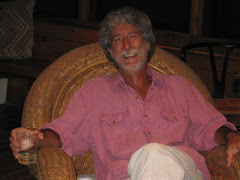And,
what did he find? Darwin would experience much, but it is the
Galapagos Islands where he left his immortal mark. Here, in an
island group of 13, roughly 600 miles off the western borders of
Ecuador, smack dab on the equator, Charlie made history. As we
approached the islands from the air, the Galapagos seemed so
inconsequential. Just tiny brownish droplets of land so small
against the Pacific you had to remind yourself that these droplets
were not weightless floating things but rather the protrusion of
mountains and volcanoes anchored to the bottom of the sea. And, at
least the islands we saw from the air were mostly brown dotted with
touches of green with slender threads of sandy beaches rimming the
islands. This would not be the jungle exploding with green
vegetation of a thousand sorts, but largely a semi-arid,
cactus-dotted environment.
Upon
arrival, our bags were closely examined to assure local officials
that we were not carrying with us any alien plant or animal life that
might threaten the fragile ecosystem we were about to explore. This
theme would emerge time and time again as we learned of the lengths
to which the locals strived to protect the local environment. No
doubt the motivation for this was driven in part by the paramount
need of the locals to protect their only viable source of income –
tourism -- but there was no questioning the sincerity of their effort
as they advised us constantly of the things we needed to be mindful
of to protect the flora and fauna from potential threats to their
well being. Even our plane was generously sprayed, including the
overhead luggage bins, to further these objectives.
We
found our way to our catamaran, our intrepid group of seven (Alex and
Katie, Jesse and Laura, Maggie, and Lily and me) and were introduced
to our guide, Oswaldo (who, for some strange reason, I kept thinking
in the early hours was named Pablo. My bad.) We would join about
eight others from Australia, England, Japan, and the U.S. and
together we would begin our exploration.
And,
what an eye opener! We were advised to never touch the animals which
I took as perhaps a bit of over cautiousness. But, soon enough we
would see that was not the case. Our daily routine was generally to
do two walking tours around the various islands and two snorkeling
adventures. What we discovered was that the animals of the Galapagos
have NO fear of human kind. None. There were moments when I was
sorely tempted to reach down and touch that blue footed boobie or
that sea lion or that pelican or marine iguana or that giant
tortoise. But, I didn't. None of us did. (Speaking of blue footed
boobies, by the way, please forgive me if I tell you that it was just
too tempting to say from time to time, “wow, that's a nice set of
boobies over there!”) Since natural instincts, I would think,
would give these animals some trepidation at human presence, I have
to think it was because of the consistent and firm instruction to
visitors over many years now not to touch the animals that this
fearlessness has become so imbedded in these creatures.
Nowhere
was this characteristic more amiably on display, and wonderfully so,
than in the water. For sure, the multitudes of brightly colored fish
kept their distance; apparently they hadn't gotten the memo. But, the
sea lions....oh my goodness! These guys, especially the young ones,
were more than just idly curious about us. They wanted to play! One
morning, for example, while casually snorkeling in the shallows
alongside a stone jetty, minding my own business, a young sea lion
spotted us and swam straight at us, no doubt to personally introduce
himself. He would swim right up to my mask, looking me straight in
the eye. If sea lions could smile, this fellow would have one ear to
ear. Without any effort, he swam within an inch or two of my face
and then, in a most coquettish way, would flip himself upside down
and spiral away. Moments later he would return, this time with his
mouth wide open – no doubt laughing – and come within a couple of
inches of my wiggling fingers. You know, the kind of wiggling of
fingers one might do when talking to a six month old baby. I'm not
sure whether he was playing tag, or keep away, or whatever, but this
young dude was having a great time. And, so was I.
And,
so it went. A wonderful flowing mix of interactions with people,
both familiar and unfamiliar, and daily encounters with animals who,
clearly, were on a first name basis with us. The Galapagos were a
wonderful discovery for us. And, I have to say, Charlie Darwin may
have bamboozled Captain Fitzroy, but I admire his chutzpah.
As
Mary, Katie's mom would say, “carpe friggin' diem!”


thanks again jeff
ReplyDeletebest,
olstudy